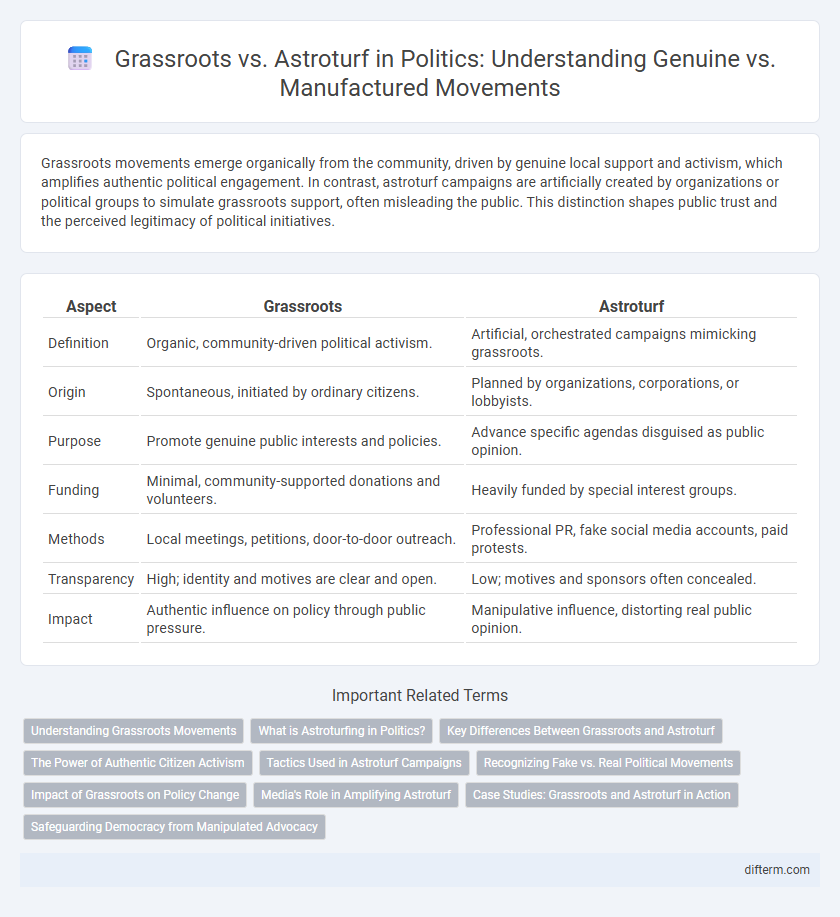Grassroots movements emerge organically from the community, driven by genuine local support and activism, which amplifies authentic political engagement. In contrast, astroturf campaigns are artificially created by organizations or political groups to simulate grassroots support, often misleading the public. This distinction shapes public trust and the perceived legitimacy of political initiatives.
Table of Comparison
| Aspect | Grassroots | Astroturf |
|---|---|---|
| Definition | Organic, community-driven political activism. | Artificial, orchestrated campaigns mimicking grassroots. |
| Origin | Spontaneous, initiated by ordinary citizens. | Planned by organizations, corporations, or lobbyists. |
| Purpose | Promote genuine public interests and policies. | Advance specific agendas disguised as public opinion. |
| Funding | Minimal, community-supported donations and volunteers. | Heavily funded by special interest groups. |
| Methods | Local meetings, petitions, door-to-door outreach. | Professional PR, fake social media accounts, paid protests. |
| Transparency | High; identity and motives are clear and open. | Low; motives and sponsors often concealed. |
| Impact | Authentic influence on policy through public pressure. | Manipulative influence, distorting real public opinion. |
Understanding Grassroots Movements
Grassroots movements emerge organically from community members driven by shared interests, contrasting sharply with astroturf campaigns that mimic such authenticity but are orchestrated by political or corporate entities. These bottom-up initiatives rely on genuine local engagement and collective action, making them powerful tools for influencing policy and social change. Understanding the dynamics of grassroots activism reveals how community-led efforts can shape legislation and public opinion more effectively than artificially constructed movements.
What is Astroturfing in Politics?
Astroturfing in politics is the practice of creating a deceptive appearance of widespread grassroots support through orchestrated campaigns funded by corporations, political groups, or interest organizations. It manipulates public opinion by masking the true source of advocacy, often using fake social media accounts, paid protests, or fabricated petitions. This tactic undermines genuine democratic engagement by distorting authentic citizen participation in political processes.
Key Differences Between Grassroots and Astroturf
Grassroots movements arise organically from community members genuinely invested in political change, reflecting authentic public sentiment and widespread participation. Astroturf campaigns, in contrast, are artificially constructed by organizations or interest groups to simulate grassroots support, often employing deceptive tactics to manipulate public perception. Key differences include origin authenticity, funding sources, participant motives, and transparency, with grassroots emphasizing genuine engagement and astroturf prioritizing strategic influence.
The Power of Authentic Citizen Activism
Authentic citizen activism drives genuine community engagement, fostering trust and long-term political change that top-down strategies often lack. Grassroots movements harness local knowledge and real concerns, creating momentum that artificial, well-funded astroturf campaigns struggle to replicate. The power of these organic efforts lies in their ability to mobilize diverse voices, ensuring democracy remains responsive and vibrant.
Tactics Used in Astroturf Campaigns
Astroturf campaigns employ tactics such as orchestrated social media manipulations, paid influencers, and fabricated testimonials to simulate genuine public support. These campaigns often utilize sophisticated data analytics to target specific demographics with tailored misinformation, creating an illusion of widespread grassroots momentum. By masking the true source of funding and organizing behind the scenes, astroturf efforts undermine authentic political engagement and distort public opinion.
Recognizing Fake vs. Real Political Movements
Distinguishing grassroots political movements from astroturf campaigns requires analyzing the origin, funding sources, and participant authenticity of each initiative. Genuine grassroots movements typically arise organically from community members with minimal centralized control, reflecting true public sentiment, whereas astroturf campaigns are often orchestrated by corporate or political entities to simulate grassroots support through artificial means. Recognizing these differences is critical for evaluating the legitimacy and impact of political advocacy efforts in shaping democratic processes.
Impact of Grassroots on Policy Change
Grassroots movements drive policy change by mobilizing local communities, generating authentic public support, and applying sustained pressure on lawmakers. Unlike astroturf campaigns, which simulate genuine activism through artificial means, grassroots efforts foster genuine civic engagement and empower marginalized voices. This authentic bottom-up influence often leads to more durable and responsive policy outcomes aligned with community needs.
Media's Role in Amplifying Astroturf
Media platforms play a critical role in amplifying astroturf campaigns by often mistaking manufactured grassroots efforts for genuine public movements, thus skewing public perception. The strategic use of paid influencers, fake social media accounts, and orchestrated messaging leverages media algorithms to create an illusion of widespread support. This amplification distorts democratic discourse by privileging artificially generated narratives over authentic community voices.
Case Studies: Grassroots and Astroturf in Action
Case studies reveal stark contrasts between grassroots and astroturf campaigns in shaping public opinion and policy outcomes. The 2009 health care reform debates showcased genuine grassroots mobilization, with community-organized town halls influencing legislative decisions, while simultaneously, astroturf efforts employed orchestrated rallies and paid advocacy to simulate widespread opposition. Analysis of these cases underlines the importance of transparency and authenticity in political advocacy for democratic accountability.
Safeguarding Democracy from Manipulated Advocacy
Grassroots movements emerge organically from the community, driven by genuine collective concerns and citizen engagement, while astroturf campaigns mimic grassroots efforts but are orchestrated by powerful entities to manipulate public opinion. Safeguarding democracy requires transparency in funding sources and stringent regulations to distinguish authentic grassroots advocacy from artificial astroturf tactics. Ensuring that civic participation reflects true public interest protects democratic institutions from covert influence and promotes accountable governance.
grassroots vs astroturf Infographic

 difterm.com
difterm.com